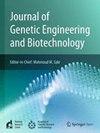Identification and characterization of Capsicum mutants using, biochemical, physiological, and single sequence repeat (SSR) markers
IF 2.8
Q3 Biochemistry, Genetics and Molecular Biology
Journal of Genetic Engineering and Biotechnology
Pub Date : 2024-12-01
DOI:10.1016/j.jgeb.2024.100447
引用次数: 0
Abstract
Identification and characterization of crop mutants through molecular marker analysis are imperious to develop desirable traits in mutation breeding programs. In the present study, macromolecular variations with altered morphological, quantitative, and biochemical traits were generated through chemically induced mutagenesis via alkylating agents and heavy metals. Statistical analysis based on quantitative traits indicating enhanced mean value in mutant lines selected from the M4 generation as compared to previous generations. Identification and characterization of morphology in selected mutant lines are based on altered phenotypes (e.g. tall and dwarf mutant with high yield, fruits with thick texture and bold seeds, etc.) in comparison to control populations. The useful mutations were recorded in phytochemicals (e.g. capsaicin and dihydrocapsaicin) and macro and micro nutrients profile (e.g. protein, iron, copper, cadmium and zinc) in selected mutant lines of Capsicum annuum L. Single Sequence Repeats (SSRs) markers analysis in selected mutant lines revealed genetic diversity in Capsicum. annuum L. The total of 44 alleles were observed with average number of allele 4.00. The Unweighted Pair Group Arithmetic Mean Method (UPGMA) showed maximum dissimilarity was recorded between mutant A-III and F-III followed by mutant G-III and C-III, while mutant B-III and G-III showed the lowest dissimilarity to each other followed by mutant L-III and mutant J-III. Correlation and Principal Component Analysis (PCA) revealed genetic diversity among mutant lines indicating their prioritization over other traits in indirect selection and also revealed that mutants treated with lower and medium concentrations were divergent. These mutant lines could be suitable in crop improvement programs for the broadening the genetic base of C. annuum L. Hierarchical Cluster Analysis (HCA) grouped the mutants into two clusters with variable euclidean distance indicated heterogeneous mutant lines developed from induced mutagenic treatments. Thus beneficial mutations could be induced in chilli genotypes via mutation breeding to enhance genetic variability in limited resources, period, and efforts.
利用生化、生理和单序列重复(SSR)标记对辣椒突变体进行鉴定和鉴定。
在突变育种计划中,通过分子标记分析鉴定和描述作物突变体对于开发理想性状至关重要。在本研究中,通过烷化剂和重金属进行化学诱变,产生了形态、数量和生化性状发生改变的大分子变异。基于数量性状的统计分析表明,与前几代相比,从 M4 代选出的突变品系的平均值有所提高。对所选突变品系形态的鉴定和表征是基于与对照种群相比发生变化的表型(如高产的高矮突变体、果实质地厚实、种子粗大等)。对所选突变品系的单序列重复标记(SSRs)分析显示了辣椒的遗传多样性,共观察到 44 个等位基因,平均等位基因数为 4.00。非加权对组算术平均法(UPGMA)显示,突变体 A-III 和 F-III 之间的相似性最大,其次是突变体 G-III 和 C-III,而突变体 B-III 和 G-III 之间的相似性最小,其次是突变体 L-III 和突变体 J-III。相关性和主成分分析(PCA)显示了突变体品系之间的遗传多样性,表明在间接选择中突变体品系优先于其他性状,同时也显示了低浓度和中浓度处理的突变体品系之间存在差异。层次聚类分析(HCA)将突变体分为两个聚类,其欧氏距离各不相同,表明诱导诱变处理产生了异质性突变品系。因此,可以通过诱变育种在辣椒基因型中诱导有益突变,从而在有限的资源、时间和精力范围内提高遗传变异性。
本文章由计算机程序翻译,如有差异,请以英文原文为准。
求助全文
约1分钟内获得全文
求助全文
来源期刊

Journal of Genetic Engineering and Biotechnology
Biochemistry, Genetics and Molecular Biology-Biotechnology
CiteScore
5.70
自引率
5.70%
发文量
159
审稿时长
16 weeks
期刊介绍:
Journal of genetic engineering and biotechnology is devoted to rapid publication of full-length research papers that leads to significant contribution in advancing knowledge in genetic engineering and biotechnology and provide novel perspectives in this research area. JGEB includes all major themes related to genetic engineering and recombinant DNA. The area of interest of JGEB includes but not restricted to: •Plant genetics •Animal genetics •Bacterial enzymes •Agricultural Biotechnology, •Biochemistry, •Biophysics, •Bioinformatics, •Environmental Biotechnology, •Industrial Biotechnology, •Microbial biotechnology, •Medical Biotechnology, •Bioenergy, Biosafety, •Biosecurity, •Bioethics, •GMOS, •Genomic, •Proteomic JGEB accepts
 求助内容:
求助内容: 应助结果提醒方式:
应助结果提醒方式:


